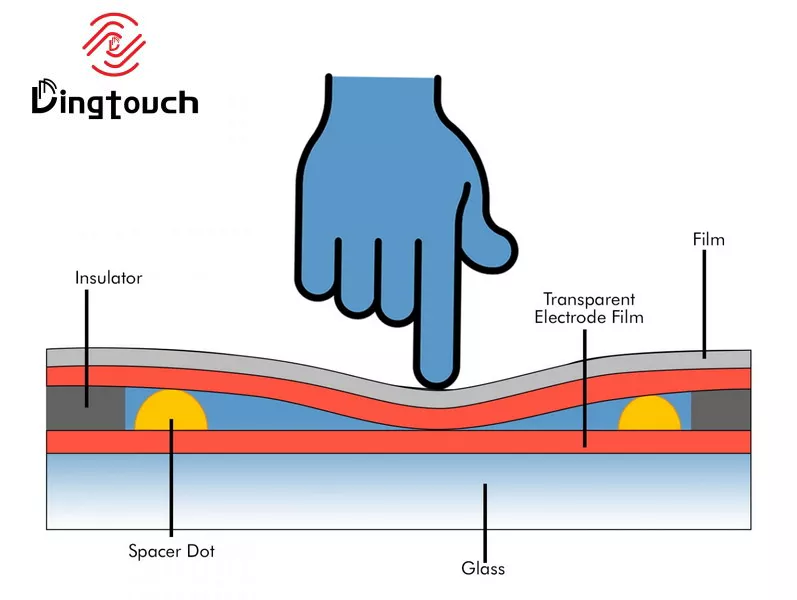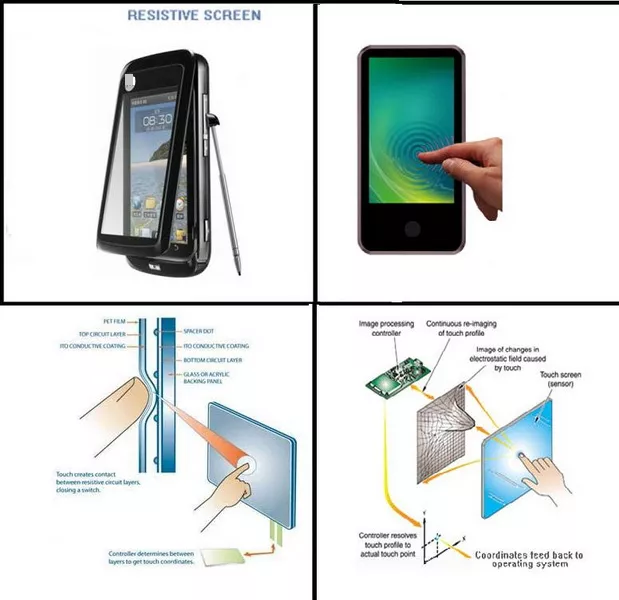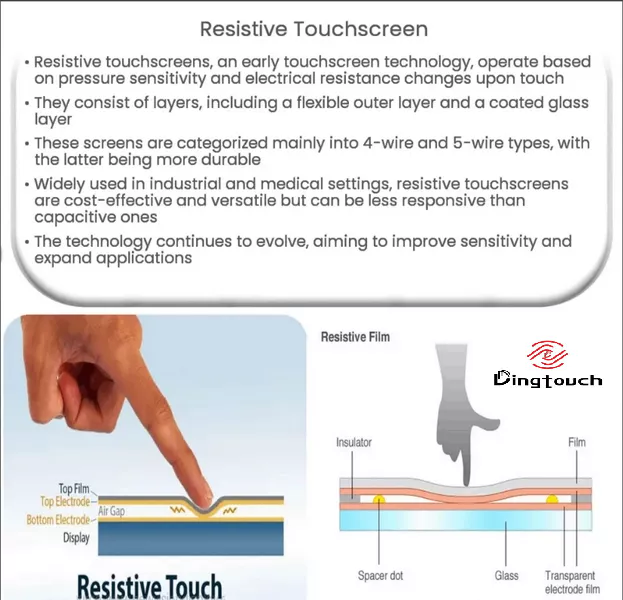News
How Resistive Touch Screen Technology Works?
How Resistive Touch Screen Technology Works?
Content Menu
● Understanding Resistive Touch Screen
>> Components of a Resistive Touch Screen
● How Resistive Touch Screens Work
● Types of Resistive Touch Screen
● Advantages of Resistive Touch Screen
● Disadvantages of Resistive Touch Screen
● Applications of Resistive Touch Screen
● Future Developments in Resistive Touch Technology
>> 1. Do resistive touchscreen support multi-touch input?
>> 2. Are resistive touchscreens more sensitive than capacitive touchscreen?
>> 3. Can I use a stylus with resistive touchscreen?
>> 4. How long do resistive touchscreen devices last?
>> 5. What are some common applications for resistive touchscreen technology?
Resistive touch screen technology is a widely used method for detecting user input on electronic devices. This technology is particularly prevalent in applications where durability and versatility are essential, such as industrial control systems, medical devices, and point-of-sale terminals. In this article, we will explore the fundamental principles behind resistive touch screens, their components, advantages and disadvantages, and their various applications.
Understanding Resistive Touch Screens
A Resistive touch screen consists of two flexible layers coated with a resistive material, separated by a small air gap or microdots. When pressure is applied to the top layer, it makes contact with the bottom layer, allowing the device to register the precise location of the touch. This technology operates on the principle of electrical resistance; when the layers touch, a change in resistance occurs that the touch controller interprets as a touch input.
Components of a Resistive Touch Screen
1. Top Layer: This is usually made from a flexible plastic material (like PET) and is the layer that users physically interact with. It is designed to deform under pressure.
2. Bottom Layer: Typically made from rigid glass or hard plastic, this layer contains a resistive coating that registers touch points when the top layer is pressed against it.
3. Spacer Dots: These tiny dots maintain a small gap between the two layers when not in use, preventing false touches.
4. Bus Bars: Conductive strips positioned on the edges of the layers that help transmit electrical signals to the touch controller.
5. Touch Controller: An electronic component that processes touch input signals and translates them into digital data.
How Resistive Touch Screens Work
The operation of Resistive touch screen can be broken down into several key steps:
- Pressure Application: When a user presses down on the top layer, it deforms and makes contact with the bottom layer.
- Resistance Change: The contact between the two layers creates a change in electrical resistance at that specific point.
- Coordinate Calculation: The touchscreen controller detects this change and calculates the exact coordinates (X and Y) of the touch based on voltage measurements across both layers.
- Signal Processing: The controller then sends this information to the device's processor to execute the corresponding action, such as opening an application or selecting an item.
Types of Resistive Touch Screens
There are several configurations of resistive touch screens, each with its unique characteristics:
- 4-Wire Resistive Touch Screen: The most basic type, using four wires for connection. It is cost-effective but less accurate than other types.
- 5-Wire Resistive Touch Screen: This design improves accuracy by using one layer solely for sensing while the other conducts touches. It is more durable and suitable for high-use environments.
- 8-Wire Resistive Touch Screen: Adds redundancy for improved reliability and extended lifespan by incorporating additional wires.
Advantages of Resistive Touch Screens
Resistive touch screens offer several benefits:
- Versatility: They can be operated with various objects, including fingers (with gloves), styluses, or any pointed object.
- Cost-Effective: Generally less expensive to manufacture than capacitive screens, making them ideal for budget-sensitive projects.
- Durability Against Contaminants: More resistant to dust and moisture than capacitive screens.
- High Resolution: Capable of achieving high resolutions (up to 4096 x 4096), providing accurate touch control.
- Low Power Consumption: Typically consume less power due to their simpler construction and operational methods.
Disadvantages of Resistive Touch Screens
Despite their advantages, resistive touch screens have notable drawbacks:
- Limited Multi-Touch Capability: Traditional resistive screens typically support only single-touch input.
- Lower Sensitivity: Require more pressure to register a touch compared to capacitive screens.
- Vulnerability to Damage: The flexible layers can be prone to scratches and wear over time.
- Reduced Transparency: Lower light transmission rates compared to capacitive screens can affect visibility under certain lighting conditions.
Applications of Resistive Touch Screens
Resistive touch screens are utilized across various industries due to their unique advantages:
1. Industrial Equipment: Frequently used in manufacturing environments where durability is essential.
2. Medical Devices: Commonly found in medical equipment that requires reliable input methods even when users are wearing gloves.
3. Point-of-Sale Systems: Widely used in retail settings for customer transactions due to their cost-effectiveness and ease of use.
4. Consumer Electronics: Found in older mobile devices and gadgets that require basic touch functionality without advanced features like multi-touch gestures.
5. Kiosks and Information Displays: Used in public places such as airports or museums where users need reliable interaction without requiring advanced gestures.
6. Home Automation Systems: Employed in smart home devices for controlling lighting, security systems, and climate control interfaces.
7. Automotive Applications: Integrated into car infotainment systems where users may need to interact with controls while wearing gloves or under varying environmental conditions.
8. Gaming Devices: Used in handheld gaming consoles where precision input is required but multi-touch functionality isn't necessary.
9. Educational Tools: Utilized in interactive whiteboards and tablets for engaging learning experiences where durability is crucial.
10. Military Applications: Often found in rugged devices designed for harsh environments where reliability is paramount.
Future Developments in Resistive Touch Technology
As technology continues to evolve, resistive touch screens are likely to see advancements aimed at improving their functionality:
- Enhanced Multi-Touch Capabilities: Newer designs may incorporate multi-touch functionality while maintaining their pressure-sensitive nature.
- Material Innovations: Development of more durable materials could enhance scratch resistance and overall lifespan.
- Integration with Other Technologies: Combining resistive technology with other sensing methods could lead to hybrid systems offering greater versatility.
- Eco-Friendly Manufacturing Practices: As sustainability becomes increasingly important, manufacturers may adopt greener practices in producing resistive touch panels.
Conclusion
Resistive touch screen technology remains relevant today due to its affordability and versatility. While it may not match the sensitivity or multi-touch capabilities of capacitive screens, its ability to function with various input methods makes it indispensable in many applications. As technology continues to evolve, resistive touch screens are likely to remain an essential component in human-computer interaction across diverse fields.
Frequently Asked Questions
1. Do resistive touchscreens support multi-touch input?
Resistive touchscreens traditionally support only single-touch input; however, some modern variants have begun incorporating multi-touch capabilities depending on design specifications.
2. Are resistive touchscreens more sensitive than capacitive touchscreens?
No, capacitive touchscreens are generally more sensitive than resistive ones because they detect changes in capacitance rather than requiring physical pressure.
3. Can I use a stylus with resistive touchscreens?
Yes! Unlike capacitive screens that require conductive inputs like fingers or specialized styluses, resistive screens can be operated with any pointed object or stylus.
4. How long do resistive touchscreen devices last?
The lifespan varies but high-quality resistive touchscreen devices can endure over 200,000 touches before showing significant wear.
5. What are some common applications for resistive touchscreen technology?
They are commonly used in industrial equipment, medical devices, point-of-sale systems, home automation controls, automotive displays, gaming devices, educational tools, and military applications due to their durability and versatility.
DINGTouch: Committed to continuous innovation and improvement of product quality to meet customers' high requirements and expectations.
DINGTouch is a manufacturer that provides high quality touch screen panels. Focus on the design, manufacturing and sales of touch screen panels, and are committed to providing customized solutions that satisfy customers.
DINGTouch: In the process of customizing touch screen panels, we focus on close cooperation and communication with customers. Understanding customers' needs and providing customized solutions will meet customers' individual needs. The company's products are favored by customers for their high quality and reliability, and provide them with the best touchscreen panel solutions.
At DINGTOUCH, we are the world's leading touchscreen manufacturer, helping businesses around the world take advantage of this exciting technology. For more information, please visit the home page now.
Find the DINGTouch technical team to achieve the success of your company's new project.
How to choose touch screen customization?
DINGTouch is a company specializing in the R&D and production of touch screen technology, headquartered in Shenzhen, China. As a professional touch screen supplier, DINGTouch is committed to providing high-quality, stable and reliable touch screen products to meet the diverse needs of customers. We continue to carry out technological innovation and product optimization to ensure that its touch screen products have good sensitivity, accuracy and durability.
In addition to the products themselves, we also focus on cooperation and communication with customers, and are committed to providing customized solutions and excellent after-sales services. Through continuous efforts to improve product quality and customer satisfaction, we have established a good reputation in the touchscreen industry and won widespread market recognition.
What DINGTOUCH can do:
• PCAP maximum size 65”
• Multi-touch (Touch screen can be customized to your needs.)
• Optical bonding service/air bonding
• LCD interface: HDMI/RGB/MIPI/LVDS/EDP, etc.
• PCAP interface: IIC/USB interface
• CTP can customize the cover glass surface treatment process AG (anti-glare), AR (anti-reflection), AF (anti-fingerprint), waterproof, and glove touch
• Supports 0.55 mm-12 mm coverslip touch.
• Support operating temperature: -40℃-90℃.
Dingtouch Industrial Capacitive Touch Screen Manufacturer
In conclusion, Dingtouch as a professional touch screen manufacturer with more than 10 years touch screen experience.We have many capacitive touch screen. Such as5 inch touch screen,7 inch touch screen,10.1inch touch screen,15 inch touch screen,15.6 inch touch screen,17 inch touch screen,18.5 inch touch screen,19 inch touch screen,21.5 inch touch screen,32 inch touch screen, However, we also welcome to customize your own touch screen . Contact our team today to learn what capacitive touch screen are best for our retail business needs.
Contact us NOW! sales@szdingtouch.com

CATEGORIES
CONTACT US
Contact: Dingtouch
Phone: +8615815536116
Tel: +8615815536116
Email: sales@szdingtouch.com
Add: Building A, Bailu Plaza, No. 48, Gonghe Industrial Road, Gongle Community, Xixiang Street, Baoan District, Shenzhen,China. 518126









 Dingtouch
Dingtouch